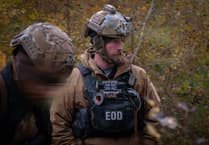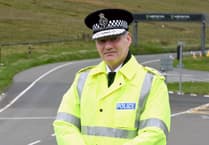Between January and October 2024, northern lights displays are set to be brighter and more frequent.
That is because 2024 has been predicted by scientists to be the solar maximum, which is the period of greatest solar activity within a solar cycle. These cycles span approximately 11 years. The more solar activity there is, the brighter the displays will be.
We spoke to northern lights enthusiast Dave Corkish, as well as Dave Kneale, chief photographer with Media Isle of Man, to get their tips for seeing the northern lights in the island.
What are the northern lights?
In simple terms, the northern lights can be explained as the interaction of the solar wind and the earth’s magnetic field.
Solar storms on the sun’s surface produce clouds of electrically charged particles.
These particles can travel millions of miles, and some may eventually collide with the Earth.
Most of these particles are deflected away, but some become captured in the Earth’s magnetic field, accelerating down towards the north and south poles into the atmosphere. This is why aurora activity is concentrated at the magnetic poles. That’s according to Royal Museums Grenwich.
How to determine if you are likely to see it
Dave Corkish said that when looking on forecasts, which can be checked on the NOAA site, it gives predictions of oncoming solar wind from the sun, and then it is a case of seeing how strong it is expected to be, which is known as the KP Index.
The KP Index goes from zero to nine.
He said that on a clear night and if statistics are right, a KP three can be seen from the island by the camera. There is a better chance of seeing it by eye when it is KP four or more.
Mr Corkish added: ‘Above a six and it will be seen by eye, which happened a few months ago and it was seen from all over the island, so the higher the better.
Dave Kneale said: ‘There is a really good app called AuroraWatch UK, which will alert you when activity is high, and ideally what you are looking for is a red alert when things really kick off.
‘But it always is a little bit random, even if there is a big red alert and everything’s clear and you think it is going to work, a lot of the time nothing really happens. ‘
‘Also, if I think something might be happening, I will check social media channels. I tend to search on X (formerly Twitter) and then you can see a live feed of people talking about the Aurora.
‘What you are looking for is where these people are based, on a really big show you will be able to follow it down the British Isles and when people start saying they can see it in Northern England, that’s when you are in business in the Isle of Man.’
Where in the island is good to go?
‘I normally stick to Peel Promenade.
‘It is easy to get to and safe, there can be around 50 people on a good night and they will help set up any bodies camera to enable them to take pictures of the aurora’, Mr Corkish said.
He added: ‘Any of the beach car parks north, Ballaugh beach, Ayre’s visitor centre, Point of Ayre are also good, as long as it is safe.
Mr Kneale said: ‘What I usually look for is somewhere that can give a sense of place to it, so I always look for some kind of landmark which is in line with the northern horizon.
‘An option is the Point of Ayre where you can get the lighthouse in the foreground of the picture, I have also seen pictures where people have used Bradda Head and Milner’s Tower.
For those photos, they are stationed at the marine biological centre, so they have Bradda Head to the north of them.
‘Another popular place I have seen is Glen Moar, which has quite distinctive anti-erosion features which makes for a really striking picture.
‘But on the right night, if you can find somewhere where it is dark, and there is not much in the way of light pollutionthere is a good chance you can get a good photo.
Tips to capture it?

Mr Kneale said: ‘The trick is to get the longest exposure you can, but with that you have to keep it steady, so you really need to have your camera or phone on a tripod or something solid so you can leave it there and not touch it.’
‘Most modern smart phones will have a night mode already built in, and things like an iphone will know its night time shot and it will shoot a long nighttime exposure for you, so they do most of the work for you.
What factors impact the likelihood of seeing the aurora?
Dave Corkish said: ‘We have to take in to account KP index, which is the speed of the solar wind; the BZ, that tells you which way the solar wind is blowing, either towards earth or away from it; density, how thick the particles in the solar wind are; BT which is the strength of the particles when it hits the special ACE satellite.
Top tips?
Mr Corkish said: ‘The aurora can be around for hours or a few minutes, normally the higher the KP number the longer it is about, when the number is high it can be seen from most of the Island in a dark area. Sometimes it can only be seen on the back of the camera, they can pick it up when the KP is low ie a 4 as shades of grey.
‘People need to dress warm as it can be a long way it doesn’t operate to a time frame, when I go out I will post a picture to Facebook when I see it and let people know it can be seen by eye.
‘I post on Isle of Man Aurora, Isle of Man Northern Lights Watch and Cumbria Aurora as Admin.
‘When I do I often say don’t move till I post, this hobby can waste countless hours waiting for it.[
‘Don’t expect to see it by eye every time, I post sites that have webcams showing the aurora.
;Since taking up this hobby following retirement and posting on Facebook it has caused a lot of interest on the Island and I own a few people who were instrumental in helping me, It has put the Island and Peel on the map in regards to Aurora watching.’
Mr Kneale said: ‘Don’t be disheartened, keep trying and be ready when the alerts happen.
‘The aurora seems to happen in quick bursts so there may be a red alert for a few hours, and somewhere in that time, there will be 20 or 30 minutes or so, where the show really happens. And even then, sometimes it happens sometimes it doesn’t, you just need to have the patience.’
Mr Kneale added that it is worth bringing a friend or telling someone where you are going for safety.
He said: ‘It is an incredible thing to witness and even if it looks better on the camera, it is still an incredible thing to see with the naked eye, and when you see the columns rising and shimmering and dancing, there is nothing like it.’
Mr Corkish added: ‘People pay thousands of pounds to travel to see it, when with a bit of patience you can see it from Peel.’

.jpeg?width=209&height=140&crop=209:145,smart&quality=75)



Comments
This article has no comments yet. Be the first to leave a comment.